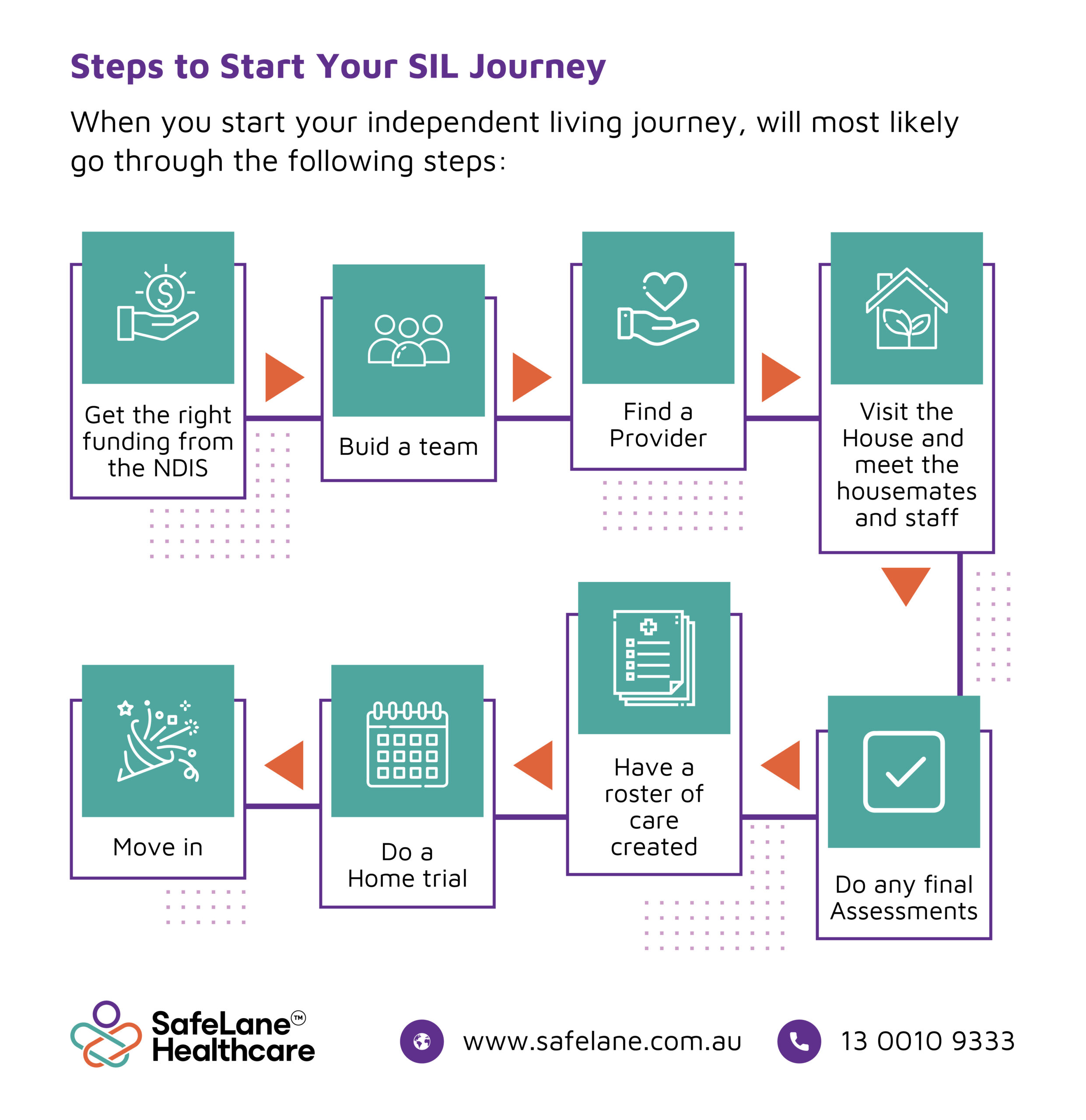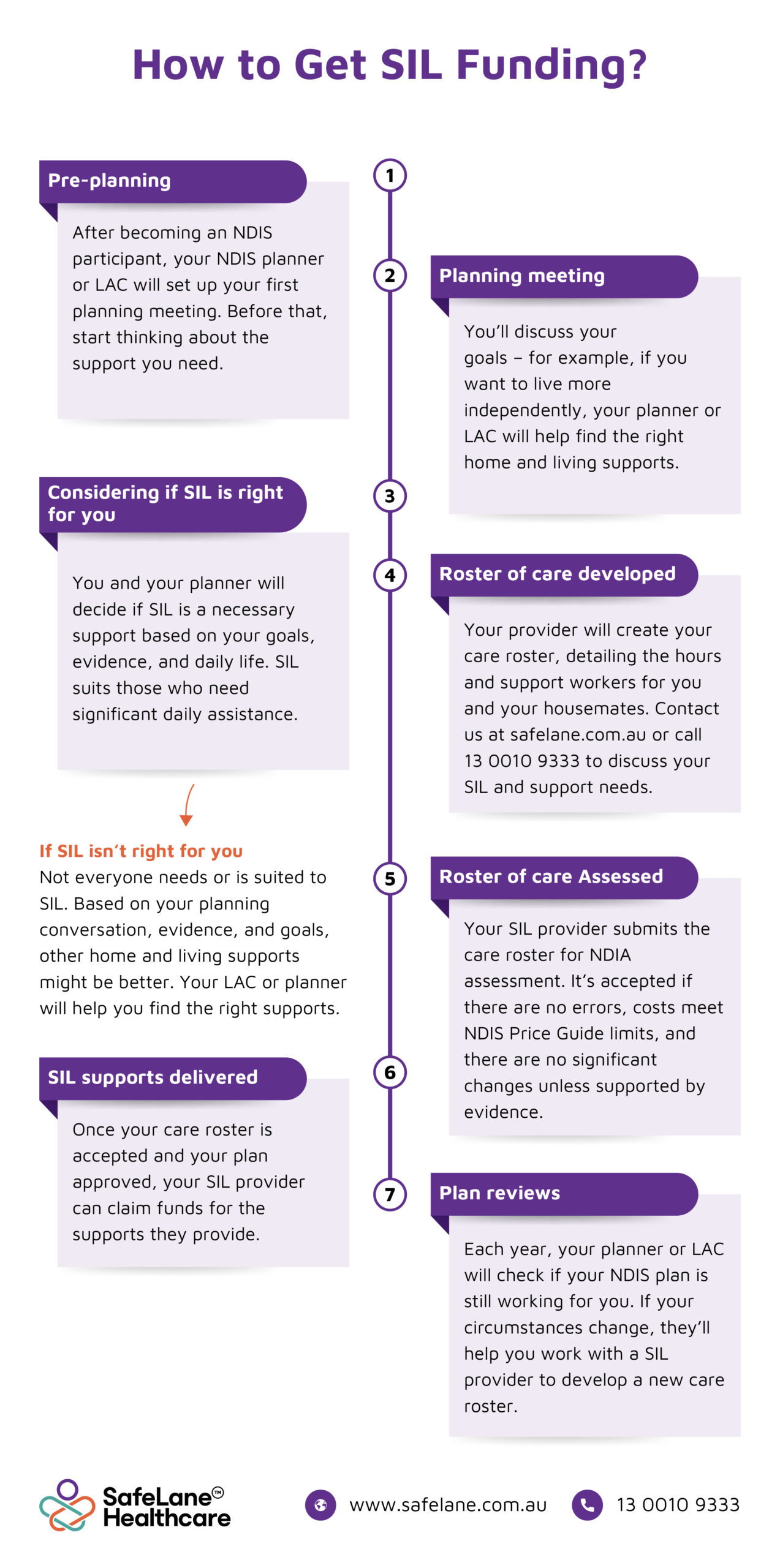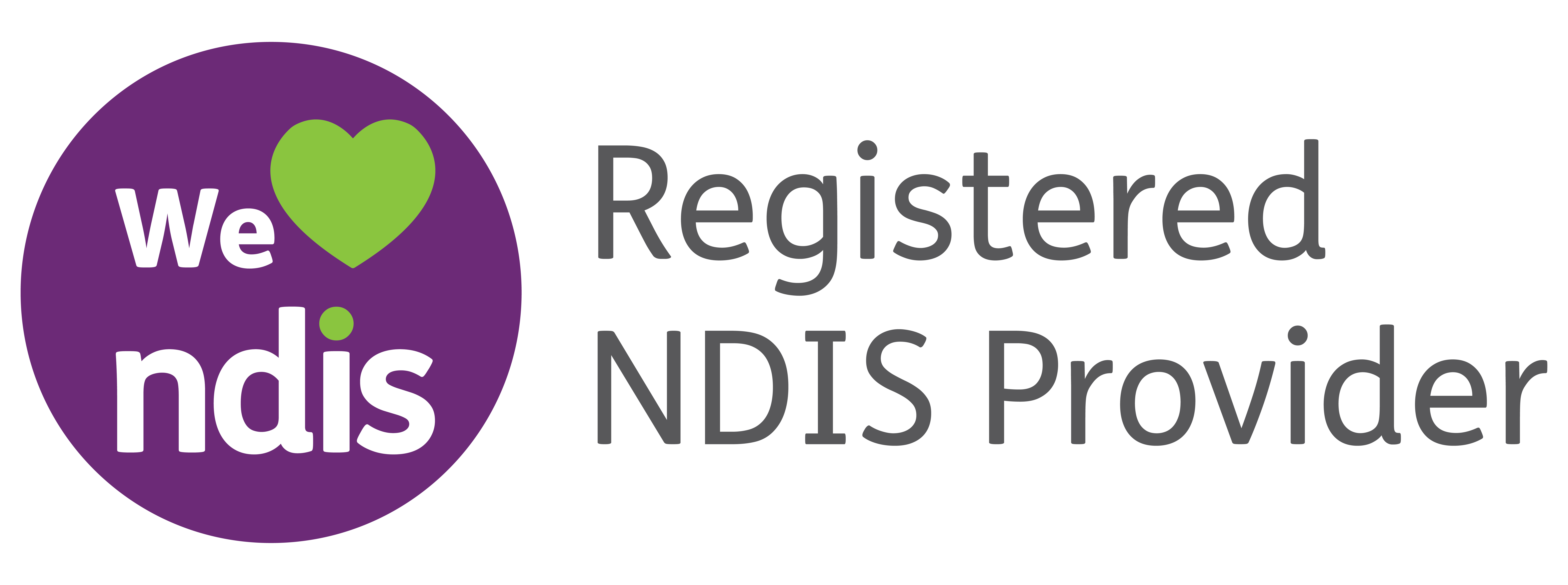
What is Supported Independent Living (SIL)?
Supported Independent Living (Also known as SIL House) is help with daily tasks so you can live more independently and develop your skills. It’s a type of support where you get paid assistance, usually in shared living arrangements.
SIL funding doesn’t cover things like rent or everyday costs such as groceries.
If you need SIL as part of your support, the funding will be provided to you and others in the shared living arrangement based on your individual needs.
SIL funding is for people who need support all day, every day, while living in a shared home. It covers the cost of support staff in the house.
SIL funding can be confusing because it works differently from other NDIS core supports. To understand how it works for you, it’s best to talk to someone directly. If you have any questions, don’t hesitate to get in touch with us.
In this handbook, we’ll explain how SIL funding works to help you start your journey toward living independently.
How to Start Your SIL Journey?
- Get your NDIS funding sorted: Secure the necessary financial support from the National Disability Insurance Scheme (NDIS).
- Put together a team: Assemble a group of people who will help you throughout your SIL journey, including family, friends, or professionals.
- Find a provider: Locate a service provider that offers Specialist Disability Accommodation (SDA) or Supported Independent Living (SIL) services.
- Check out the house and meet the housemates and staff: Visit the accommodation to see if it suits your needs and meet the people you’ll be living with and the staff who will support you.
- Complete any final assessments: Finish any required evaluations to ensure everything is in place before moving in.
- Set up a care roster: Create a schedule for the care and support you’ll need, detailing who will provide it and when.
- Try out the home with a trial stay: Live in the house temporarily to make sure it’s the right fit for you.
- Move in: Settle into your new home and start your new living arrangement.

What's the Difference Between SIL and SDA?
It can be a bit tricky to tell them apart because they sound similar. But here’s the simple difference:
- Supported Independent Living (SIL) is the funding for the support services you need.
- NDIS Specialist Disability Accommodation (SDA) is the actual place where you live and receive those services.
[Sometimes, one provider can offer both SIL and SDA, like SafeLane Healthcare.]
To put it another way:
A SIL provider: They manage the support services, meaning they provide the workers who help you with daily tasks at home. Their goal is to help you become as independent as possible.
An SDA provider: They take care of the house itself, like a landlord or property manager. SDA is for people with very high support needs. It ensures that they don’t have to pay extra for their home because of their disability. Only a small percentage of NDIS participants will receive SDA funding in their plan.
SIL (Supported Independent Living)
| SDA (Specialist Disability Accommodation)
|
Supported Independent Living Planning Process
Getting funding from the NDIS means your NDIS planner needs to see that it’s reasonable and necessary for you.
When you have your planning meeting, you’ll need to explain why SIL funding is important for your situation.
We’ve noticed that the more you prepare, the better your chances of getting the right funding package.
Remember, the NDIS Planner doesn’t know you personally. They only know what you tell them. So, if your need is urgent, make sure you clearly explain that to your planner.

What are the Levels of SIL Funding?
SIL (Supported Independent Living) funding comes in three levels based on how much support someone needs and how many people live in the shared home. The three levels are:
- Lower Need: This level offers supervision for living arrangements, but not 24/7.
- Standard Need: This level provides 24/7 support, including help with most daily tasks and overnight stays.
- Complex Need: This level offers very frequent help for managing challenging behaviours, complex medical needs, and continuous support 24/7, including overnight care.
For more details on these levels, please check the NDIS Price Guide.
How Does the SIL Funding Work?
SIL funding works a bit differently from most other NDIS funding. Here’s how it works:
How most NDIS funding works:
- You get your NDIS plan with specific amounts of money for different categories.
- You choose the service providers you want.
- You sign up to receive the supports.
How SIL funding works:
- You get SIL funding in your plan, but it doesn’t come with a set dollar amount.
- You work with your Support Coordinator and talk to the necessary people (like an Occupational Therapist) to figure out the level of support you need.
- You and your Support Coordinator find a suitable house.
- Your SIL provider gives a quote for the whole house.
- The SIL provider also gives a quote for each person in the house, showing what their ‘typical week’ looks like.
- You get your NDIS plan with specific amounts of money for different categories.
- You choose the service providers you want.
- You sign up to receive the supports.
The NDIS will cover the reasonable and necessary costs of SIL, so you won’t have to pay out of pocket. Usually, the SIL provider will deal directly with the NDIA (National Disability Insurance Agency).
Who Can Help You on Your SIL Journey?
When you’re navigating the process of Supported Independent Living (SIL), you won’t have to go through it alone. Here’s who can help you on this journey:
- Support Coordinator: Your Support Coordinator is your main guide through the SIL process. They assist you in exploring your options, organizing your steps, and finding solutions tailored to your needs. Since you’ll be spending a lot of time together, it’s crucial to have a good rapport with them.
- Family: Moving out of home is a significant milestone, and it’s often a big adjustment for the whole family. Having everyone on the same page helps make the transition smoother.
- Your Supports: Beyond the logistical aspects, moving out involves being emotionally, physically, and mentally prepared. Your supports, whether paid professionals or informal networks, will help you build the necessary skills, confidence, and readiness for this change.
- Healthcare Professionals: To ensure you receive the appropriate supports, you’ll likely need to attend various appointments and consultations. An Occupational Therapist is commonly involved to help assess and address your specific needs.
This team of people is there to support and guide you through the SIL process, ensuring that you have the help and resources needed to succeed.

Exploring Alternatives to Supported Independent Living (SIL)
You might need help with daily tasks like getting out of bed or getting ready in the morning, but not require full-time personal support. In that case, other NDIS-funded supports could work better for you. For example, you might get help with daily living through Assistance with Daily Living (ADL), or you might use assistive technology at home.
Why Finding the Right SIL House Takes Time
Finding the right SIL (Supported Independent Living) home can take time because there are many factors to consider.
- Getting the Right Support Ratio: During your assessment, they’ll work out the right ratio of support workers to housemates for you. This ratio can range from 1:1 to 1:7. For everyone in the house to be a good fit, their support ratios usually need to be similar.
- Occupational Therapist Approval: Before moving into any home, an Occupational Therapist (OT) must approve it. The OT will assess your needs to ensure the home is suitable for you. This assessment is part of the SIL application. The OT doesn’t approve each property individually, but their assessment will help decide if the home is right for you. You’ll likely work with your Support Coordinator to get this approval.
- Compatibility with Other Tenants: You need to get along with the people you’ll be living with. Just like in any other living situation, it’s important to be compatible with your housemates. This is no different under the NDIS.
(Note: In very rare cases, the NDIS might approve two support workers for one resident if it’s seen as reasonable and necessary.)
Real-Life Example: How SIL Helps
Jack has moved out of his family home with support from SIL funding. After joining the NDIS, Jack now lives with his housemate Ben. Jack is so busy socially that his mum, Sarah, jokes they need to book a visit in advance!
Jack’s SIL funding lets him live independently. Support workers visit him in the morning and afternoon and stay overnight to help with cooking, cleaning, and other household tasks. They also assist with shopping and getting Jack involved in the community.
Jack’s dad, Michael, says, “The NDIS has given Jack a fantastic chance to live away from home and become more independent. Before, there weren’t many opportunities for him to hang out with people his own age and interests. Now he’s always out with friends, going to markets, or having coffee. Jack is doing so many things and having fun. The NDIS helps him grow and enjoy life.”
Jack works a nine-day fortnight at a local laundry company, where he has been employed for over 10 years. He’s also very active, playing basketball, athletics, rowing, and karate.
While Jack is enjoying his social life, his parents are relieved knowing he has support for his future. “Jack’s disability isn’t as visible or severe as others, so he often slipped through the cracks. But he still needs help with decisions, outings, and household tasks, and the NDIS now covers that, which is great. Our main worry was what would happen to Jack if something happened to us. The NDIS has provided the support he needs.”
Final Words
To wrap things up, Supported Independent Living (SIL) can help you live more independently with the right support. By getting the right NDIS funding, building a support team, and finding the right place to live, you can start this new chapter with confidence. SafeLane Healthcare is here to make this process easier for you. We’re ready to help you every step of the way. If you have any questions or need support, just give us a shout. Contact us at https://safelane.com.au/sil-housing/ today.
Frequently Asked Questions
1. What does the NDIS pay for, and what do I pay for?
Good question! If a person without a disability would pay for something, then it probably won’t be covered by the NDIS. The NDIS is meant to help with costs related to disability, so you’ll usually pay for rent and board just like anyone else.
The NDIS offers two types of funding for home support: Supported Independent Living (SIL) for support services, and Specialist Disability Accommodation (SDA) for the place you live.
2. What’s included in rent and board?
Here’s a simple breakdown:
Included in Rent and Board:
| Not Included in Rent and Board:
|
3. How do meals and cooking work?
This can vary from house to house. Most housemates plan meals, shop, cook, and eat together. They might set up a cooking roster or work as a group. Special diets and allergies are considered, and while support is available, housemates make the decisions about meals. If someone prefers to cook their own meals, that’s fine too.
4. What does 24/7 support mean?
24/7 support means there’s always someone available to help if needed. However, staff are not around all the time; they are there to offer support when you need it while respecting your privacy and independence.
5. How does it work with household group activities?
If everyone in the house is doing an activity, it’s usually covered by SIL funding. If only some people want to join, the activity probably won’t be covered by SIL. In that case, you might need to use other NDIS funding for community access.
6. Can I use my own support worker?
Yes, you can!
- If your support worker is not paid by your SIL funding, you can choose anyone you like, even if they are not an Endeavour Foundation employee.
- If your support worker is paid by SIL funding, they will be an Endeavour Foundation employee.
7. What are the housemates like?
To find out, you should get in touch with us! We don’t share personal details online for privacy reasons, but we can give you general information. You’ll also get a chance to meet the housemates during a Home trial before you move in, which helps ensure everyone gets along well.
8. What is an Individualised Living Option (ILO)?
An ILO is another way to get support, similar to SIL. It helps you choose how and where you want to live and who you want to live with. With ILO, you can live with friends or on your own with the support you need. Note that SIL and ILO supports cannot be funded at the same time.
Subscribe Our Newsletter
Join our newsletter for community updates and resources.


